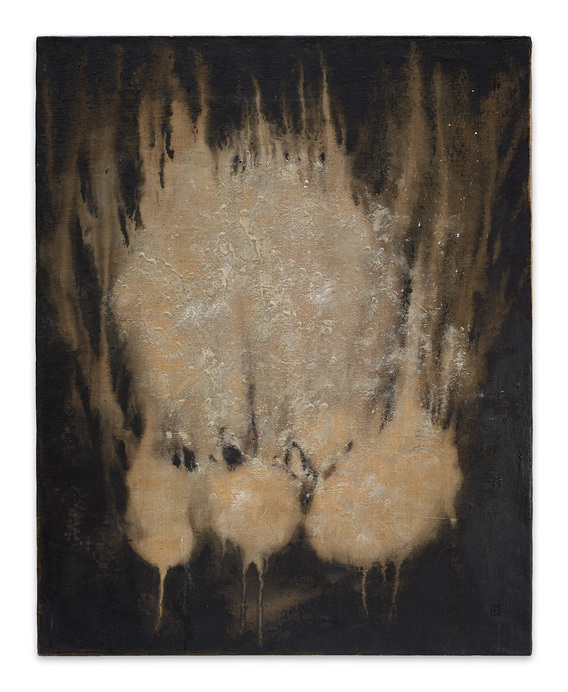-
From Current Issue
-
- Editor’s Letter Fire in the Heart
- Reviews I Gusti Ayu Kadek Murniasih
- Reviews 11th Seoul Mediacity Biennale: “One Escape at a Time”
- Dispatch Networked China
- One on One Monira Al Qadiri on Yukio Mishima
- Essays The rise of independent art spaces in pandemic-era Shanghai
- Features Tuan Andrew Nguyen
- Table of Contents
- Web Exclusives
- Archive
- Subscribe

R
E
V N
E
X
T
Installation view of RYUJI TANAKA’s solo exhibition at Axel Vervoordt Gallery, Hong Kong, 2019–20. All images courtesy the artist and Axel Vervoordt Gallery, Hong Kong / Wijnegem.
In 1948, upon graduation from the Kyoto Municipal School of Painting, Ryuji Tanaka co-founded the Pan-real Art Association, which sought to revitalize nihonga by introducing new forms and subjects. By the 1960s, Tanaka had experienced a shift in his practice, joining the Gutai Art Association and producing works that explore relationships between matter, space, and time, with a focus on expressing human spiritual freedom. The artist’s second posthumous solo show at Axel Vervoordt Gallery, Hong Kong, featured 18 works spanning the 1960s to 1990s, tracing Tanaka’s evolving abstract style under the influence of the two avant-garde movements in which he was involved. The works presented exemplify the movements’ radical ideals in their departure from old paradigms, yet, importantly, they highlight how Tanaka’s changing aesthetic remained true to the beauty of Japanese nihonga.
Made in accordance with Japanese aesthetic conventions, techniques, and materials, typical nihonga pieces consist of mineral pigments on washi paper or silk, applied with animal glue using brushes, and finished with paint or sumi ink. Works such as Kishi no Fudo (The Nature of the Knight) (1967) evidenced Tanaka’s mastery of this arduous technique, which he elevated by using gold leaf, pebbles, and other crushed metals. Created during the height of his involvement in Gutai, the composition’s intense red and black colors evoke the palette of nihonga, while layer upon layer of paint, pigments, minerals, and sediment, in some places thicker than others, imbue the stunning piece with three-dimensionality. The additional crushed metals render a sheen that enlivens its otherwise somber tone. But what gives it theatricality and movement are the swirling and swelling amorphous forms, seemingly random scratches and “unfinished” areas. They reveal hidden colors, textures and nuances that imbue it with a lyricism both poetic and spiritual.
Another 1960s work on display was Sei A (c. 1963), one of many of the same name and style produced by the artist in that era. Sei (Japanese for “house”) paintings feature mineral pigments centered among a dark background, applied in excess to the canvas and allowed to drip with the glue to take on lives of their own. What distinguishes Sei A from the rest of the series is that here, Tanaka has rendered the forms curiously anthropomorphic, calling to mind the dark, strangely alluring upside-down paintings of Georg Baselitz.
In addition, the exhibition showcased four large pieces from the 1980s. Significant portions of the large surfaces are left blank, with a clear distinction between the foreground and background. The bold and dancing brushstrokes possess dramatic qualities once again strongly echoing Gutai principles of freedom and performativity. The bursts of colors in Untitled (1986) and Untitled (2 parts) (1983) further depart from the artist’s previous earth-toned works, and draw the eye towards the calligraphic strokes. With three of these works presented as polyptychs that recall the displays of medieval religious works, perhaps they seek to invite the viewer into a state of meditation and reflection.
RYUJI TANAKA, Untitled (2 parts), 1983, ink, mineral pigments and mixed media on paper, 180 × 181 cm each.
Worthy of mention is one of the exhibition’s smallest and most recent pieces, Fuji ’97 (Classics) (1997), which shows Tanaka playing with color and figuratism to depict Japan’s most famous mountain peak. Portrayed with a brilliant manganese blue, the painting displays no less depth in spite of the thinner and fewer layers typical of the artist’s later works.
The survey showed Tanaka exploring significantly varied styles over the course of the years, and was revealing in two ways. Firstly, it portrayed the artist as a visionary who was not content to conform and who always looked to move ahead of his time; the numerous paintings presented showcased his playful experimental style, be it in technique or choice of media. Secondly, it emphasized Tanaka’s devotion to nihonga throughout his practice despite his avant-garde tendencies; he was faithful to his training and never sought to abandon it, instead choosing to revolutionize the genre. His art-making was an empirical approach to reconcile the two, and encapsulated the lofty Gutai credo of doing “what no one has done before.”
Ryuji Tanaka’s solo exhibition is on view at Axel Vervoordt Gallery, Hong Kong, until February 1, 2020.
To read more of ArtAsiaPacific’s articles, visit our Digital Library.



















